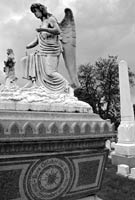This article is part of a series on How Historic Laurel Hill Cemetery Is Reinventing Itself. It is based on an interview with Ross Mitchell, Executive Director of Laurel Hill Cemetery in Philadelphia, PA.
Stoneangels: As far as actually getting to Laurel Hill, you can see it from Roosevelt Boulevard, but you have no idea how to get in!
Ross Mitchell: Yes, thousands drive by every day on Kelly Drive, but the entrance is on Ridge Avenue. The neighborhood was not inviting in years gone by, although there’s definitely a change happening. The part of the cemetery that most people see is the Kelly Drive and Hunting Park intersection, but you can’t enter there-and you can only see a little sliver of the cemetery. You have no idea what’s above on the cliffs [overlooking the Schuylkill River]. The cemetery was built up here for the scenic vistas-the rural garden cemetery movement usually called for a lake-we have a river.
Stoneangels: Is there any plan to change the entrance to make it more accessible?
Ross Mitchell: We plan to improve the signage. The East Falls Economic Development Corporation has a grant for signage so hopefully we will be able to get listed on their signage on Kelly Drive. We are working on making East Falls a more desirable destination in general. We look at ourselves as the “Gateway to East Falls.”
Stoneangels: I see the new condos going up down the street.
Ross Mitchell: Hopefully they will bring a few thousand more people to the community. And with the Sherman Mills project up and running, East Falls will be a vibrant location with Laurel Hill as a cultural and ecological center uniting the community. In addition to increasing our signage on Kelly Drive, we want to reopen our Hunting Park gate and encourage joggers, bikers, and strollers who are going up Kelly Drive to make a little detour into the cemetery.
Stoneangels: I read in the “Stone in America” article that one of your first efforts to make Laurel Hill more accessible was to have it open on weekends. Personally, that was terrific for me! It was so hard for me to get in here; I really appreciated it.
Ross Mitchell: It was so hard to get in! Everybody works during the week and it was only open until noon on Saturday.
Stoneangels: Have you any parting words, Ross?
 Ross Mitchell: People really need to come here and see Laurel Hill for themselves. They need to overcome their inhibition of ‘why would I want to visit a cemetery’ and realize that not all cemeteries are very depressing places. In fact I think this one is really a celebration of life. And you talk about, well, isn’t it disrespectful? If you look at the monuments and the sculpture in Laurel Hill you know these people wanted these monuments to be seen. They wouldn’t have spent thousands of dollars, in fact the largest mausoleum we have–the Disston mausoleum-in 1886 it cost $60,000 to build! A small modest mausoleum can easily cost $600,000 to a million dollars to build today.
Ross Mitchell: People really need to come here and see Laurel Hill for themselves. They need to overcome their inhibition of ‘why would I want to visit a cemetery’ and realize that not all cemeteries are very depressing places. In fact I think this one is really a celebration of life. And you talk about, well, isn’t it disrespectful? If you look at the monuments and the sculpture in Laurel Hill you know these people wanted these monuments to be seen. They wouldn’t have spent thousands of dollars, in fact the largest mausoleum we have–the Disston mausoleum-in 1886 it cost $60,000 to build! A small modest mausoleum can easily cost $600,000 to a million dollars to build today.
Stoneangels: Why is it that people don’t build monuments and mausoleums anymore?
Ross Mitchell: People are building mausoleums today…at our sister cemetery, West Laurel Hill in Bala Cynwyd, there were three or four mausoleums built last year. But many people are not as rooted as they once were, with the mobility we have, people move all the time. We have large lots that are owned by families, but the family has spread out over the country. And many people are cremating nowadays, they’re not as rooted to the city, they’re not as rooted to the earth.